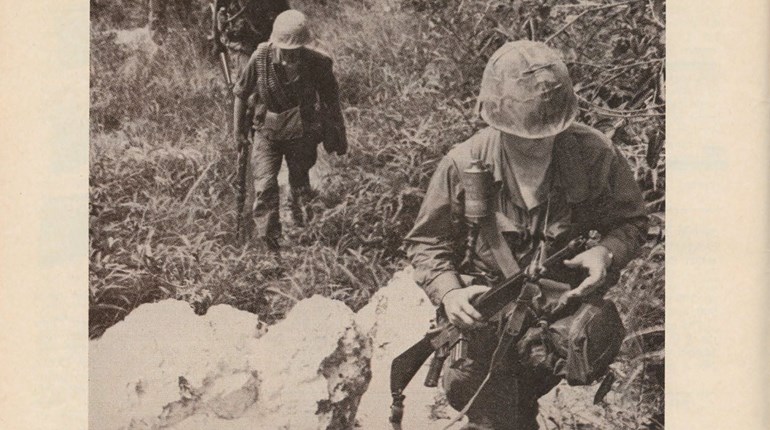
The French Foreign Legion saw significant combat in what was then known as French Indochina. While the legion fought valiantly, it could not prevent the establishment of an independent, divided Vietnam.
Growing up during a war and living in an armory as I did, I guess I was just naturally drawn to all things military. The public library in Pomona, CA, was well-stocked with books pertaining to military history, and I was reading early. The wonderful ladies who ran the place knew a reader when they saw one. They never failed to clue me into the intriguing intricacies of the Dewey Decimal System or how to work the card file. By the time I left junior high school, I had a basic reader’s background in military history, and I am still at it. My interests were in contemporary military history, particularly infantry. I went on to an education at a military college and served 11 years in the Marine Corps as an infantry officer. So what?
It explains my interest in a military organization that is sometimes regarded with more than a little suspicion. For some unknown reason, I became intrigued with the military history of France, which is a pretty wide subject. In the year 1831, the king of France decreed a new branch of the French Army, which was constituted by soldiers of non-French origin. It was called The French Foreign Legion (Légion étrangère) and it remains alive and well today.
The Legion enjoys a reputation for military efficiency to rival any of modern times. At its origin, the “international” composition of the Legion was to imply a certain objectivity to its work, but the government of France has seldom hesitated to use these soldiers for whatever might be needed. For close to 200 years, there have been few lengthy intervals when the Legion—or some part of it—has not been deployed to active combat somewhere in the world. Its members have been, literally, international troubleshooters. More than a few times, France has rented out portions of the Legion to friendly countries in need of professional soldiers, too. No, I never signed up or even considered doing so, but the process is interesting.
Although the Legion of the 21st century is somewhat different from the Legion of the past, it is mostly similar. It shares the tradition of anonymity. New recruits may enlist under an assumed name and the Legion will protect their identity. Supposedly, one of the reasons for enlistment in the Legion is an affair of the heart. A five-year hitch in the Foreign Legion is enough to cool anyone down. The internet is full of stories about the Legion in action, and particularly about its boot camp, which I believe is what gets TV and internet coverage—not the one that produces the polished Legionnaires of the Bastille Day parade.
Training for the Foreign Legion is brutally hard. It is not that much longer than any first-class military basic, but much more difficult. It gets recruits from all over the world who speak languages from all over the world. All the business of the Legion is rendered in French. Therefore, the Foreign Legion teaches the French language to recruits. The recruits are required to learn it—whether or not they are capable of learning it. A focused study of Legion traditions and procedures uncovers many oddities. For example, every Legionnaire learns how to march in step. Their speed is ponderously slow at 88 counts per minute. This is a reminder of the slow speed mandated by the shifting sands of the African deserts.
When World War II ended, France tried to put everything back the way it was beforehand. In the area known as French Indochina, communist resistance to colonial rule began as early as 1946. It was a guerilla war that lasted until the massive defeat of a large French outpost at Dien Bien Phu and the eventual division of the contested territory into North and South Vietnam. For 10 long years, a generation of French soldiers struggled with the problems inherent in fighting a guerilla war. American readers can learn about that war in Bernard Fall’s classic book “Street Without Joy,” a particularly poignant treatise on the battles along what was known as “Route One.” A significant number of Legionnaires deployed to Indochina were Germans, recruited from the collapsed Nazi armies, many of whom doubtless fought against the Free French in World War II. But, for Legionnaires of any country, it became “... the Legion is my country,” and they really meant it.
France still had interests in South Vietnam after the fall of Dien Bien Phu, but the United States became the main stabilizing force. Almost as soon as the documents that divided Vietnam were signed, (and national elections cancelled), the North began armed infiltration into the South. Eventually, infiltration became a staged invasion, and it became our Vietnam War. The various Legion units were long gone, now part of the French struggle to hang on to the colony of Algeria, but they left reminders of their service along that same “Street Without Joy.”
I was in an infantry battalion of the 1st Marine Division by the Spring of 1966. We were tangled up with a strong unit of NVA regulars. They were dug into fortifications in a village along the north bank of an east-flowing river. Since this enemy almost never stood its ground and fought you, we were surprised. We wanted to attack across a wide expanse of rice paddy and had a costly time doing it. It became quite a complicated engagement that saw a lot of ordnance expended. We took some casualties, but delivered more. The next day, I scouted the battlefield. The enemy was long gone, but there was evidence of many enemy wound-ed in the form of used bandages. In the process of going through grisly evidence, I found an old coat half burned from napalm. A few buttons bore the words “La Légion étrangère.”
I brought a button home It serves to remind me I was not the only guy who ever went down that joyless street with fightin’ iron.




































